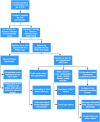Exploring the potential of a school-based online health and wellbeing screening tool: professional stakeholders' perspectives and experiences
- PMID: 35168580
- PMCID: PMC8848969
- DOI: 10.1186/s12889-022-12748-2
Exploring the potential of a school-based online health and wellbeing screening tool: professional stakeholders' perspectives and experiences
Abstract
Background: Supporting children and young people's (CYP) mental and physical health is a global policy priority but detecting need and facilitating access to health services and support is challenging. This paper explores professional stakeholders' perspectives of the acceptability, utility and effectiveness of a school-based online health and wellbeing screening tool, the Digital Health Contact (DHC). The DHC, delivered by Public Health School Nurses (PHSN), aims to identify, and put in place strategies to support, unmet health needs among CYP.
Methods: We employed a qualitative study design, using semi-structured interviews. Fourteen key stakeholders involved in the design and implementation of the DHC (commissioners, providers, PHSN and healthcare staff, school leaders) were purposively sampled. Data were analysed thematically.
Results: Our analysis generated two key themes: the perceived benefits of the DHC; and challenges in delivering the DHC. Stakeholders perceived the universal application of the DHC with linked follow-up intervention as an effective means of identifying and supporting CYP with unmet needs, and an efficient way to target limited service resources. There were barriers around enabling school engagement in the DHC, typically in terms of logistics, school infrastructure, and perspectives of fit with schools. These barriers were seen as being negated through developing effective working relationships between schools and PHSN. Effective relationships could highlight the potential benefits of participation. Overall, the DHC was seen as a valuable and effective use of resources, with a low burden on school staff.
Conclusions: The DHC, as a universal school-based health and wellbeing screening tool with linked follow-up intervention, has great potential in identifying and supporting unmet health needs among CYP. The perspectives and experiences of those involved in delivering the DHC highlight important considerations which may enable effective implementation and delivery of school screening programmes across other areas.
Keywords: Children and young people; Health screening; School.
© 2022. The Author(s).
Conflict of interest statement
NW, HF, KB, KD, PNA, RC and FDV do not have any conflicts of interest.
Similar articles
-
The impact of the newly developed school-based 'Digital Health Contact'-Evaluating a health and wellbeing screening tool for adolescents in England.PLoS One. 2024 Jan 12;19(1):e0297016. doi: 10.1371/journal.pone.0297016. eCollection 2024. PLoS One. 2024. PMID: 38215072 Free PMC article.
-
Exploring the Potential of a School-Based Online Health and Wellbeing Screening Tool: Young People's Perspectives.Int J Environ Res Public Health. 2022 Mar 29;19(7):4062. doi: 10.3390/ijerph19074062. Int J Environ Res Public Health. 2022. PMID: 35409747 Free PMC article.
-
Effective implementation of primary school-based healthy lifestyle programmes: a qualitative study of views of school staff.BMC Public Health. 2019 Sep 9;19(1):1239. doi: 10.1186/s12889-019-7550-2. BMC Public Health. 2019. PMID: 31500603 Free PMC article.
-
Healthcare stakeholders' perceptions and experiences of factors affecting the implementation of critical care telemedicine (CCT): qualitative evidence synthesis.Cochrane Database Syst Rev. 2021 Feb 18;2(2):CD012876. doi: 10.1002/14651858.CD012876.pub2. Cochrane Database Syst Rev. 2021. PMID: 33599282 Free PMC article.
-
Co-production as an Emerging Methodology for Developing School-Based Health Interventions with Students Aged 11-16: Systematic Review of Intervention Types, Theories and Processes and Thematic Synthesis of Stakeholders' Experiences.Prev Sci. 2021 May;22(4):475-491. doi: 10.1007/s11121-020-01182-8. Epub 2020 Nov 25. Prev Sci. 2021. PMID: 33237552 Free PMC article.
Cited by
-
The impact of the newly developed school-based 'Digital Health Contact'-Evaluating a health and wellbeing screening tool for adolescents in England.PLoS One. 2024 Jan 12;19(1):e0297016. doi: 10.1371/journal.pone.0297016. eCollection 2024. PLoS One. 2024. PMID: 38215072 Free PMC article.
-
Exploring the Potential of a School-Based Online Health and Wellbeing Screening Tool: Young People's Perspectives.Int J Environ Res Public Health. 2022 Mar 29;19(7):4062. doi: 10.3390/ijerph19074062. Int J Environ Res Public Health. 2022. PMID: 35409747 Free PMC article.
-
Development of a Smart Health Care Service Using Metaverse and Chatbot Technologies for Adolescents, Parents, and School Health Teachers: User-Centered Design Approach.J Med Internet Res. 2025 Jul 3;27:e69190. doi: 10.2196/69190. J Med Internet Res. 2025. PMID: 40607742 Free PMC article.
-
Addressing the Ethical, Legal, and Social Issues of Healthtech in Education: Insights From Japan.JMIR Form Res. 2025 Jul 18;9:e72781. doi: 10.2196/72781. JMIR Form Res. 2025. PMID: 40680270 Free PMC article.
References
-
- Were WM, Daelmans B, Bhutta Z, Duke T, Bahl R, Boschi-Pinto C, Young M, Starbuck E, Bhan MK. Children’s health priorities and interventions. Bmj. 2015;14;351. - PubMed
-
- Kieling C, Baker-Henningham H, Belfer M, Conti G, Ertem I, Omigbodun O, Rohde LA, Srinath S, Ulkuer N, Rahman A. Child and adolescent mental health worldwide: evidence for action. The Lancet. 2011;22(9801):1515–25. - PubMed
-
- NHS. The NHS Long Term Plan; 2019. https://www.longtermplan.nhs.uk/wp-content/uploads/2019/08/nhs-long-term.... Accessed 6th April 2021.
-
- NHS Digital. Smoking, Drinking and Drug Use among Young People in England 2018; 2019 https://digital.nhs.uk/data-and-information/publications/statistical/smo.... Accessed 10 Jan 2021.
-
- NHS Digital. Mental Health of Children and Young People in England, 2020: Wave 1 follow up to the 2017 survey; 2020. https://files.digital.nhs.uk/AF/AECD6B/mhcyp_2020_rep_v2.pdf. Accessed 6th April 2021.
Publication types
MeSH terms
LinkOut - more resources
Full Text Sources


